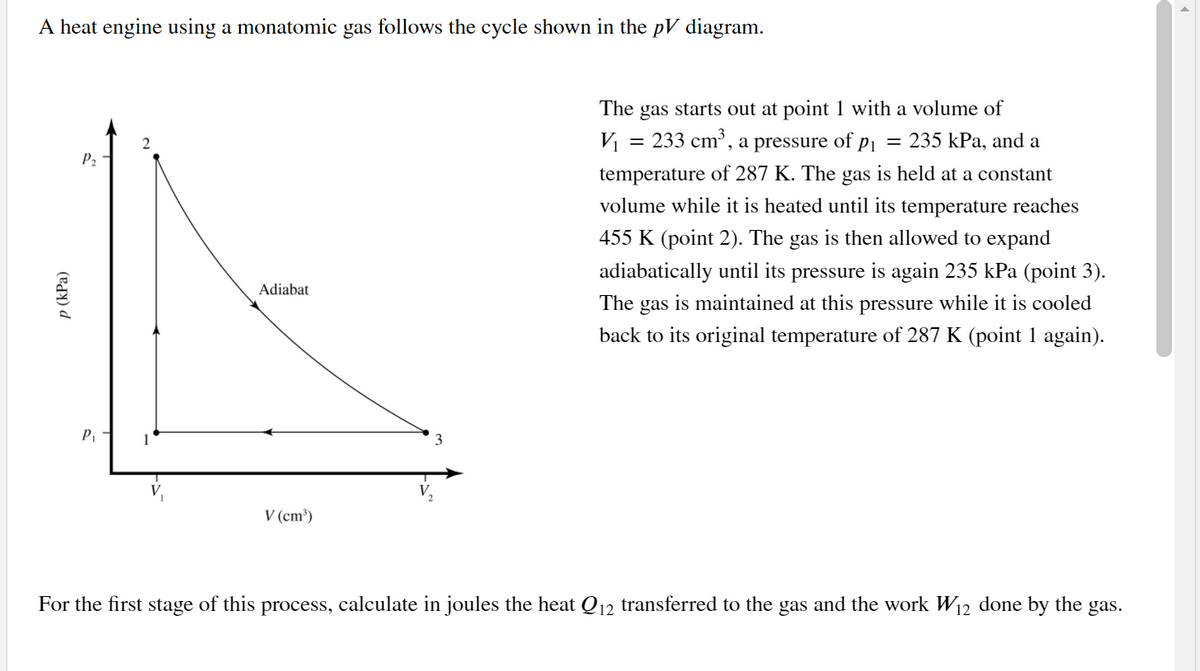A heat engine using a monatomic gas follows the cycle shown in the ?? diagram. The gas starts out at point 1 with a volume of ?1=233 cm3, a pressure of ?1=235 kPa, and a temperature of 287 K. The gas is held at a constant volume while it is heated until its temperature reaches 455 K (point 2). The gas is then allowed to expand adiabatically until its pressure is again 235 kPa (point 3). The gas is maintained at this pressure while it is cooled back to its original temperature of 287K (point 1 again). For the first stage of this process, calculate in joules the heat ?12 transferred to the gas and the work ?12 done by the gas. ?12= ?12= For the second stage, calculate the heat ?23 transferred to the gas and the work ?23 done by the gas. ?23= ?23= For the third stage, calculate the heat ?31 transferred to the gas and the work ?31 done by the gas.
A heat engine using a monatomic gas follows the cycle shown in the ?? diagram. The gas starts out at point 1 with a volume of ?1=233 cm3, a pressure of ?1=235 kPa, and a temperature of 287 K. The gas is held at a constant volume while it is heated until its temperature reaches 455 K (point 2). The gas is then allowed to expand adiabatically until its pressure is again 235 kPa (point 3). The gas is maintained at this pressure while it is cooled back to its original temperature of 287K (point 1 again). For the first stage of this process, calculate in joules the heat ?12 transferred to the gas and the work ?12 done by the gas. ?12= ?12= For the second stage, calculate the heat ?23 transferred to the gas and the work ?23 done by the gas. ?23= ?23= For the third stage, calculate the heat ?31 transferred to the gas and the work ?31 done by the gas.
Principles of Physics: A Calculus-Based Text
5th Edition
ISBN:9781133104261
Author:Raymond A. Serway, John W. Jewett
Publisher:Raymond A. Serway, John W. Jewett
Chapter18: Heat Engines, Entropy, And The Second Law Of Thermodynamics
Section: Chapter Questions
Problem 61P
Related questions
Question
A heat engine using a monatomic gas follows the cycle shown in the ?? diagram.
The gas starts out at point 1 with a volume of ?1=233 cm3, a pressure of ?1=235 kPa, and a temperature of 287 K. The gas is held at a constant volume while it is heated until its temperature reaches 455 K (point 2). The gas is then allowed to expand adiabatically until its pressure is again 235 kPa (point 3). The gas is maintained at this pressure while it is cooled back to its original temperature of 287K (point 1 again).
For the first stage of this process, calculate in joules the heat ?12 transferred to the gas and the work ?12 done by the gas.
?12=
?12=
For the second stage, calculate the heat ?23 transferred to the gas and the work ?23 done by the gas.
?23=
?23=
For the third stage, calculate the heat ?31 transferred to the gas and the work ?31 done by the gas.

Transcribed Image Text:A heat engine using a monatomic gas follows the cycle shown in the pV diagram.
The gas starts out at point 1 with a volume of
2
= 233 cm³, a pressure of p1 = 235 kPa, and a
P2
temperature of 287 K. The gas is held at a constant
volume while it is heated until its temperature reaches
455 K (point 2). The gas is then allowed to expand
adiabatically until its pressure is again 235 kPa (point 3).
Adiabat
The gas is maintained at this pressure while it is cooled
back to its original temperature of 287 K (point 1 again).
P,
V (cm³)
For the first stage of this process, calculate in joules the heat Q12 transferred to the gas and the work W12 done by the gas.
р (КРа)
Expert Solution
This question has been solved!
Explore an expertly crafted, step-by-step solution for a thorough understanding of key concepts.
This is a popular solution!
Trending now
This is a popular solution!
Step by step
Solved in 3 steps with 8 images

Knowledge Booster
Learn more about
Need a deep-dive on the concept behind this application? Look no further. Learn more about this topic, physics and related others by exploring similar questions and additional content below.Recommended textbooks for you

Principles of Physics: A Calculus-Based Text
Physics
ISBN:
9781133104261
Author:
Raymond A. Serway, John W. Jewett
Publisher:
Cengage Learning

Physics for Scientists and Engineers, Technology …
Physics
ISBN:
9781305116399
Author:
Raymond A. Serway, John W. Jewett
Publisher:
Cengage Learning


Principles of Physics: A Calculus-Based Text
Physics
ISBN:
9781133104261
Author:
Raymond A. Serway, John W. Jewett
Publisher:
Cengage Learning

Physics for Scientists and Engineers, Technology …
Physics
ISBN:
9781305116399
Author:
Raymond A. Serway, John W. Jewett
Publisher:
Cengage Learning
